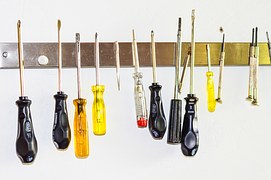There are even more different types of screwdrivers than there are types of screws, since there is a screwdriver tip designed for each kind of screw as well as variations in the screwdriver’s own shape, material or drive mechanism. What follows is a guide to the most common types.
Standard flat blade screwdriver
A standard flat blade screwdriver was the original screwdriver, with a wooden handle, a metal shaft and a tapering flat blade. It is still widely used, although wooden handles have largely given way to other materials. This type of screwdriver is designed to turn straightforward slotted screws used in woodwork.
Manual or motorized
A screwdriver can be a hand tool, where the torque is provided by the human operator, or a motorized device usually powered by batteries. Some powered screwdrivers are large tools resembling a power drill with a handle at right angles to the blade, while others look more similar to a manual screwdriver. Powered screwdrivers obviously require less strength and effort from the user and are popular with both the home handyperson and tradespeople.
Handle type
A screwdriver with a smooth, pear-shaped wooden handle is now most likely to be a vintage piece in the collection of a dedicated woodworker, although it is still possible to buy this type of screwdriver. However, new screwdrivers usually have rubber and plastic handles with ridges or fluting to provide a better grip.
Inventors and the needs of industry have driven the evolution of the screw, to the point where the plain slotted screw is outnumbered by the myriad of screws developed for special purposes. The most common ones include the Phillips cross-head screw, with variations called PoziDriv and Frearson, the star-shaped Torx and the square-shaped Robertson. There is, of course, a corresponding screwdriver available to drive each of these screw types.
Magnetic tip screwdriver
Hard-to-handle tiny screws are often paired with a magnetic tip screwdriver. This magnetic feature is often found in jewelers’ screwdrivers or precision screwdrivers. Computers and other electronic devices often use the tiniest of screws, but the jury appears to be still out on whether electronics and magnetic tip screwdrivers are a good mix.
Offset screwdriver
An offset screwdriver has a handle set at right angles to the blade, either to provide more torque or to permit access to narrow spaces where it would be impossible to operate a conventional screwdriver. Some offset screwdrivers are double-ended, having a blade at right angles at each end. In this case there will usually be a conventional flat tip on one blade and a Phillips tip on the other.
Allen wrench or hex key
An Allen wrench or hex key is simply a kind of L-shaped offset screwdriver with a hexagonal tip, to turn a screw with a hexagonal depression in its head. Multiple sizes are available. Its most common use is in self-assembly furniture kits and bicycle adjustment.
Detachable bit screwdriver
It is possible to buy not only power screwdrivers but also manual screwdrivers with a single handle and a set of detachable bits of various types. This eliminates the need to own a large bundle of screwdrivers to fit all the different kinds and sizes of screw.
Ratchet screwdriver
Manual ratchet screwdrivers, which have a spiral ratchet mechanism which converts the operator’s pushing motion into a clockwise or counter-clockwise rotation to drive a screw, have largely been superseded by powered screwdrivers.
There is evidence that screwdrivers were used in late 15th century England, so they have been evolving for at least four hundred years. There are already many different variations on the basic model, and the likelihood is that the screwdriver will continue to develop in functionality along with the new applications being found for the fundamental technology involved.

